Asteromonas is a genus of green algae in the family Asteromonadaceae. It has been described from saline, marine, and brackish environments. It is closely related to the genus Dunaliella, another genus common in saline waters.
Atractomorpha is a genus in the Sphaeropleaceae, a family of green algae. The genus name is derived from Greek and means "spindle-shaped" or "arrow-shaped", and refers to the shape of the cells.
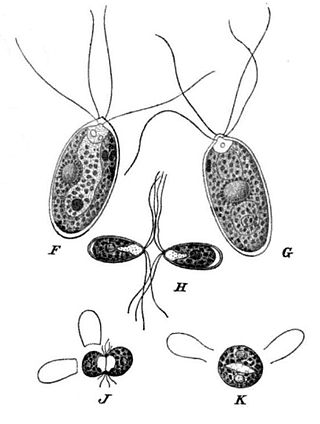
Carteria is a genus of green algae in the family Chlamydomonadaceae. Carteria are similar in morphology to the common genus Chlamydomonas and differ by having four, rather than two, flagella at the vegetative stage.
Characiochloris is a genus of green algae in the family Characiochloridaceae. Characiochloris is epiphytic on freshwater algae, or found in soil.
Characiosiphon is a genus of green algae in the family Characiosiphonaceae. It contains a single species, Characiosiphon rivularis.
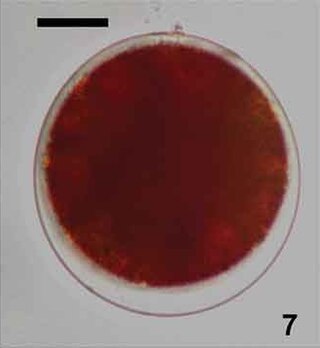
Chlainomonas is a genus of algae in the family Chlamydomonadaceae. They are found in freshwater habitats or on snow, where they are one of the main algae responsible for causing watermelon snow.

Chlamydocapsa is a genus of green algae, specifically of the Chlorophyceae.
Lobocharacium is a genus of green algae in the family Characiosiphonaceae. It contains the single species Lobocharacium coloradoense. It has been isolated from a pond in Colorado, United States.

Lobomonas is a genus of green algae in the family Chlamydomonadaceae, found in freshwater habitats. Although it is widely distributed, it is a rare genus.
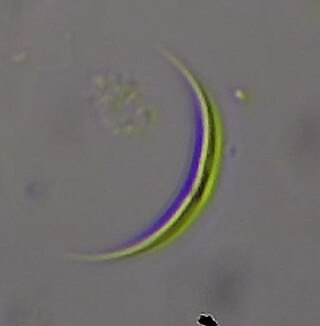
Monoraphidium is a genus of green algae in the family Selenastraceae. Monoraphidium is found free-floating or attached to surfaces in water, or in soils. It is one of the most common types of phytoplankton in freshwater habitats, and has a cosmopolitan distribution.
Palmellopsis is a genus of green algae, specifically of the Palmellopsidaceae. They are either planktonic or attached to substrates in fresh water, or in aeroterrestrial habitats.
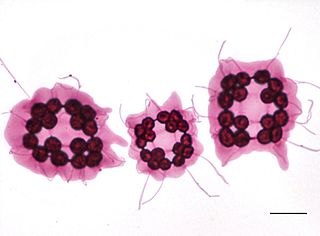
Platydorina is a genus of microscopic green algae in the family Volvocaceae. It contains only one species, Platydorina caudata. It was described by Charles Atwood Kofoid in 1899.
Pseudoschroederia is a genus of green algae in the family Characiaceae. It is planktonic in freshwater habitats, and probably has a cosmopolitan distribution. The genus Pseudoschroederia was circumscribed by Eberhard Hegewald and Eberhard Schnepf in 1986. The genus was distinguished from the similar Schroederia by being heteropolar and differing cell structure. However, some authors do not consider the genera to be separate.
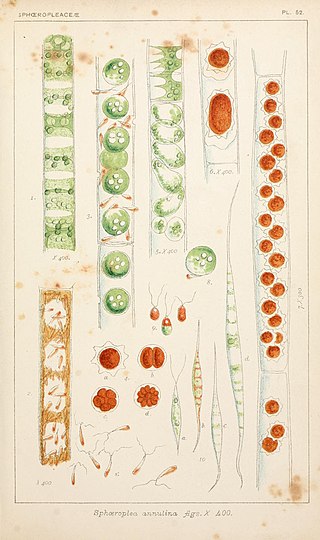
Sphaeroplea is a genus of green algae in the family Sphaeropleaceae. It was first circumscribed by the Swedish botanist Carl Adolph Agardh in 1824.
Vitreochlamys is a genus of green algae in the family Chlamydomonadaceae. It is sometimes known by the name Sphaerellopsis, published by Aleksandr Arkadievich Korshikov. However, that name is an illegitimate later homonym, preceded by SphaerellopsisM.C.Cooke. It is commonly found in freshwater habitats.
Korshikoviella is a genus of green algae in the family Characiaceae.
Cecidochloris is a green algae genus in the family Chlorangiellaceae. It occurs in freshwater. However, it has only been reported so far from Europe, with an additional species from India that is incompletely described.
Cryptoglena(/ˌkɹɪptoʊˈgliːnə/) is a genus of photosynthetic euglenids that was first described in 1831 by Christian Gottfried Ehrenberg. Today, its circumscription is controversial: Bicudo and Menezes consider twenty-one species as Cryptoglena, of which, nine are uncertain. Cryptoglena species are water-based, living in both freshwater and marine environments. They are biflagellated, with one internal flagellum and one external flagellum, which allows movement through environments as demonstrated by Kim and Shin in the species C. pigra. The cells of Cryptoglena resemble a coffee bean, as they have a groove that runs the length of the cell on one side and makes them U-shaped in cross section. They are ovoid in shape and are small, with the larger cells being on average 25 x 15 μm. After being first described in 1831, little work was done on the genus until the late 1970s and early 1980s, after the scanning electron microscope completed development and was implemented into laboratories. Work then proceeded with the developments of molecular biology, which allows for classifications based on DNA sequences. For Cryptoglena the main DNA used for classification are small subunit (SSU) and large subunit (LSU) rDNA.

Apiocystis is a genus of algae belonging to the family Tetrasporaceae. It is found attached to freshwater aquatic algae or plants. The species of this genus are found in Europe and Northern America, and are widespread but generally uncommon.

Chlorangiella is a genus of microscopic green algae, the type genus of the family Chlorangiellaceae. The name Chlorangiella was coined by Giovanni Battista de Toni in 1889. It is a nomen novum for Chlorangium F.Stein.









